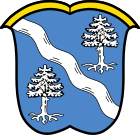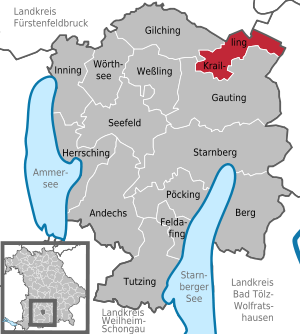Krailling
| coat of arms | Germany map | |
|---|---|---|

|
Coordinates: 48 ° 6 ' N , 11 ° 24' E |
|
| Basic data | ||
| State : | Bavaria | |
| Administrative region : | Upper Bavaria | |
| County : | Starnberg | |
| Height : | 548 m above sea level NHN | |
| Area : | 15.99 km 2 | |
| Residents: | 7867 (Dec. 31, 2019) | |
| Population density : | 492 inhabitants per km 2 | |
| Postcodes : | 82152, 82205 (Hüll) , 82349 (Frohnloh, Pentenried) |
|
| Area code : | 089 | |
| License plate : | STA, WOR | |
| Community key : | 09 1 88 127 | |
| LOCODE : | DE KIG | |
| Community structure: | 4 districts | |
| Address of the municipal administration: |
Rudolf-von-Hirsch-Strasse 1 82152 Krailling |
|
| Website : | ||
| Mayor : | Rudolph Haux ( FDP ) | |
| Location of the municipality of Krailling in the Starnberg district | ||
Krailling is a municipality located northeast in the Upper Bavarian district of Starnberg . It borders on the districts of Munich and Fürstenfeldbruck .
geography
The community is located in the planning region of Munich. The municipality covers an area of 16.0 km². The place is located in the Würmtal , about 14 kilometers north of the district town of Starnberg and four kilometers southwest of Munich .
The settlement area of the main town has grown together with that of the municipality of Planegg , also belongs to the parish of Planegg and has the same postcode , but in contrast to Planegg, it does not belong to the district of Munich, but to the district of Starnberg. Krailling is the northernmost town in the Starnberg district, but is assigned to the Munich telephone prefix (089). To the south, the settlement area merges seamlessly into the Gauting district of Stockdorf .
The municipality has four officially named districts (the type of settlement is given in brackets ):
- Envelope ( good )
- Frohnloh ( Kirchdorf )
- Krailling (Kirchdorf)
- Pentenried (Kirchdorf)
The districts are widely scattered. In the middle of the Kreuzlinger Forst forest area lies the “KIM” industrial area (Kraillinger Innovations Meile). There are the districts Frohnloh and Krailling.
history
Until the church is planted
The oldest traces of settlement documented here date from 150 to 100 BC. Several Celtic pieces of jewelry, shards and house posts were found on the property of the Linnermühle . This makes Krailling, together with Buchendorf and Steinebach am Wörthsee, one of the few Celtic settlements in the south of Munich.
A pottery kiln and a waste pit also found there date from the period between 200 and 300 AD. Traces of Roman settlement were not found, however. Numerous finds also prove a Bavarian settlement on the Würmufer from 600 to 900 AD.
Until the end of the 18th century, Krailling was the seat of a court marque of the Barons von Ruffin. This Hofmark was part of the Electorate of Bavaria . In the course of the administrative reforms in Bavaria , today's municipality was created with the municipal edict of 1818 .
20th century
After the Second World War, many refugees and displaced persons settled in the district of Pentenried, which has been significantly influenced by this population group since then. Since 1975 there has been a town partnership with Paulhan in the Hérault department in southern France.
Population development
Between 1988 and 2018 the municipality grew from 7,280 to 7,772 by 492 inhabitants or 6.8%.
| Course of population development | ||||||||||||||
|---|---|---|---|---|---|---|---|---|---|---|---|---|---|---|
| year | 1840 | 1900 | 1939 | 1950 | 1961 | 1970 | 1987 | 1991 | 1995 | 2005 | 2010 | 2015 | ||
| Residents | 249 | 793 | 2027 | 3725 | 4634 | 7064 | 7346 | 7310 | 7284 | 7570 | 7529 | 7666 | ||
politics
mayor
- The first mayor of the community is Rudolph Haux (FDP). He was elected to office in 2019 as the successor to Christine Borst (CSU).
Municipal council
| year | CSU | SPD | Green | FDP | FBK | UWK | total | WB |
|---|---|---|---|---|---|---|---|---|
| 2020 | 7th | 2 | 6th | 2 | 3 | 0 | 20th | 60.6% |
| 2014 | 9 | 3 | 4th | 1 | 2 | 1 | 20th | 60.2% |
| 2008 | 10 | 2 | 3 | 2 | 2 | 1 | 20th | 64.0% |
| 2002 | 11 | 3 | 1 | 1 | 2 | 2 | 20th | 66.8% |
FBK = Free Civic Community Krailing
UWK = Independent voters Krailing
coat of arms
On a blue background, a silver wave flow crosses diagonally from top left to bottom right, symbolizing the Würm. At the bottom left and at the top right there is a silver fir tree for the Kreuzlinger Forst and Forst Kasten forests .
Town twinning
Culture and sights
Buildings
The Margaret Church is a striking building in the town . It was first mentioned in a document in 1315. In 1747 it received its present appearance with the onion dome . The outside of the church was completely renovated in 2005/2006.
The foundations and cellars of the former castle were found during archaeological excavations in 2005. The basement foundations were uncovered and preserved with a roof. Stone borders show the earlier extent and a plaque explains the history of the Hofmarkschloss .
The villa of the architect Martin Dülfer (1902), one of the pioneers of Art Nouveau in Germany, has an attractive Baroque Art Nouveau facade. Unfortunately, the organic-abstract stucco decoration is no longer preserved.
Architecturally remarkable is the “Black House”, a single-family house in the main workers' settlement of the Upper Bavarian Homestead (1936–1937), which was modified in 2006 by Peter Haimerl and covered with bitumen shingles.
monument
Since 1989, a bronze sculpture by the sculptor Hubertus von Pilgrim on Gautinger Straße has been a reminder of the death march of thousands of prisoners from the Dachau concentration camp in April 1945, monitored by the SS . 20 identical sculptures are still on the entire route. A copy of the monument is a gift from the municipality Gauting in 1992 Shoa -Gedenkstätte Yad Vashem in Jerusalem.
Economy and Infrastructure
Kraillinger Innovations Mile
The Kraillinger Innovations Meile (KIM) is an industrial park founded in 1996 that offers space for around 120 small and medium-sized companies. The largest company on the site is EOS GmbH , a manufacturer of industrial 3D printers. The approximately 90,000 m² KIM is located on the former pioneer training area of the Bundeswehr in the Kreuzlinger Forest and borders the neighboring communities of Gauting and Germering . A siding , the most Bahnhof München-Freiham by the Munich-Herrsching railway branches off the tank farm Krailling (former IVG area) is on the rail network of railway Deutsche connected. The KIM itself has no siding.
traffic
Krailling is served by public transport buses. The Munich-Garmisch-Partenkirchen railway runs through the town, but has no station there. The next train stations in Planegg, Stockdorf and Gauting are served by the S6 line of the Munich S-Bahn .
The main thoroughfare of the Kraillinger Zentrum is Gautinger Strasse, which runs parallel to the Würm. The parts to the west are connected, among other things, by Pentenrieder Straße with the Kraillinger center, although these districts have long been oriented towards Gauting in terms of infrastructure.
schools
Krailling has a three-course elementary school (Krailling Elementary School) with three all-day classes.
Personalities
- The painter Otto Ackermann-Pasegg (1882–1959) died in Krailling.
- The folk actor Gustl Bayrhammer (1922-1993) died in Krailling and was buried there.
- Walter Schultze (1894–1979), a former Reichsdozentenführer and National Socialist from the very beginning, died in Krailling.
- The sculptor Rudolf Belling (1886–1972) lived and died in Krailling.
- The architect Martin Dülfer (1859–1942) lived in Krailling.
- The baritone Hermann Prey (1929–1998) lived in Krailling (Fichtenstrasse 14), died here and is buried in the Kraillinger cemetery.
- The Russian exile journalist and church historian Gleb Rahr (1922–2006) lived in Krailling from 1980 to 1991.
- The publisher Erich Wewel (1894–1974) lived with his family from 1937 to 1951 in Krailling. His publishing house was also here in the Würmtal .
- The art historian Wolfgang Braunfels (1911–1987) lived and died in Krailling.
- The geographer and hammer thrower Wolfram Hausmann (1922-2006) lived in Krailling and is buried there.
- The pediatrician and university professor Erich Aschenheim (1882–1941) lived in Krailling for the last few years.
- The actress and entertainer Lisa Fitz (* 1951) grew up in Krailling and attended the Planegg-Krailling elementary school until 1961.
- The academic sculptor Leopold Hahn (1894–1970) lived since 1939, had his studio there since 1951 and died in 1970 in Krailling.
- The German internet pioneer and entrepreneur Sebastian von Bomhard lives with his family in Krailling.
- The legal scholar and professor for civil law , international private law and comparative law at the Ludwig Maximilians University in Munich Stephan Lorenz (* 1961) lives in Krailling.
literature
- Heike Werner: Architecture excursions from Munich: Würmtal & surroundings. Munich, 2011, ISBN 978-3-9809471-4-5 .
Web links
- Website of the Krailling municipality
- Entry on Krailling's coat of arms in the database of the House of Bavarian History
Individual evidence
- ↑ "Data 2" sheet, Statistical Report A1200C 202041 Population of the municipalities, districts and administrative districts 1st quarter 2020 (population based on the 2011 census) ( help ).
- ^ Krailling municipality in the local database of the Bavarian State Library Online . Bavarian State Library, accessed on September 9, 2019.
- ^ Krailling municipality (2010): Time window of the past. The history of the Linner property on the Würm in Krailling . Krailling. Pp. 6-9.
- ↑ Time window of the past . Pp. 10-13.
- ↑ Bavarian State Office for Statistics and Data Processing , accessed on July 16, 2014.
- ↑ https://okvote.osrz-akdb.de/OK.VOTE_OB/Wahl-2020-03-15/09188127/html5/Gemeinderatswahl_Bayern_116_Gemeinde_Gemeinde_Krailling.html
- ↑ Coat of arms of the Krailling community
- ↑ Bronze sculpture by the sculptor Hubertus von Pilgrim in Krailling on Gautinger Strasse, next to the Würm river. The inscription reads: IN THE LAST DAY OF THE WAR IN APRIL 1945 THE PATH OF THE PRISONERS FROM THE DACHAU CONCENTRATION CAMP LEADED THROUGH THE UNCERTAIN. Meinolf Wewel took the picture during a memorial visit on November 24, 2006. He and his brother Godehard encountered the “death march” on April 27, 1945 on the way to Gauting at around this point. Her father Erich Wewel wrote after her report in his diary: "A gruesome event that is impossible to describe."
- ^ List of memorials in memory of the Dachau death marches. (No longer available online.) Archived from the original on September 24, 2015 ; Retrieved November 26, 2017 . Info: The archive link was inserted automatically and has not yet been checked. Please check the original and archive link according to the instructions and then remove this notice.
- ↑ Memorial sites for the victims of National Socialism. A documentation, volume 1. Federal Agency for Civic Education, Bonn 1995, ISBN 3-89331-208-0 , p. 156.
- ↑ Kim - Kraillinger Innovations Meile. Retrieved December 11, 2017 .
- ↑ Giessen University Library
- ↑ The Russian Munich. Publishing house Mir e. V., Munich 2010. ISBN 978-3-9805300-9-5
- ↑ Awarded the Order of Merit of the Federal Republic of Germany. Retrieved February 9, 2019 .











